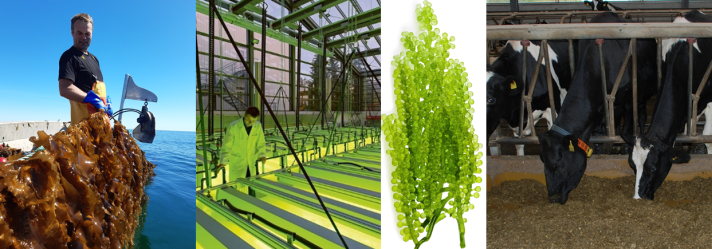An analysis has shown that the European Union’s strategy for reaching zero carbon by 2050 will require more wood for burning, shift one-fifth of cropland to bioenergy and outsource deforestation. Much of the cropland is used for animal feed. Can a switch to algae, produced in the sea or on land unsuitable for farming, make up for this loss?
A first-rate team of consultants, scientists and academics have completed a study on the potential and consequences of substituting micro and macro algae for other types of feed in the EU. The study summarizes the current state of knowledge (in terms of yields, production costs, CO2 emissions), assesses EU potential algae production, and analyses the potential of using algae in animal diets.
The results, based on literature review, a survey and expert interviews, show wide variations according to species, types of cultivation system and scale and growing conditions, sometimes by an order of magnitude. We should, therefore be careful in drawing definitive conclusions. With these reservations, interesting findings include:
- yields in terms of dry mass, protein and lipids per unit area of cultivation are higher for micro than macro algae, but macroalgae may have higher yields in terms of carbohydrates. Land-based macroalgae has higher yields than sea-based.
- the carbon footprint of growing microalgae is higher than of macroalgae.
- algae for feed is an order of magnitude more expensive than crops such as soya.
- on average, microalgae tend to have higher production costs than macroalgae. But there are large variations depending on location, capacity, productivity, scale of operations, and cost assumptions For microalgae, with current electricity prices, energy would be 40% of operating costs. For macroalgae there is wide variation and little information in the literature because it is a very small-scale activity in the EU. But capital costs tend to be higher.
- The potential for inland production of land-based algae fed by flue gases in the EU is constrained by flue gas availability, the suitability and convertibility of land, area requirements and slope. The potentially convertible area to algae production in Europe is 100,000km2 , biomass production ranges from 150 to 400 million tonnes of dry weight per year, CO2 capture ranges from 160 to 700 million tonnes per year and potential nutrient uptake ranges from 5 to 20 million ton of nitrogen per year. Such pathways do not provide net CO2 removal from the atmosphere, but they can reduce emissions via industrial CO2 capture that displaces fossil fuel use.
- trace minerals are major barriers for the use of most macroalgae species as feed for food-producing animals and for microalgae cultivated in mineral contaminated waters as concentrations could exceed toxicity limits. If the issue is solved, Palmaria palmata has high digestibility and protein content, and could include up to 10% of animal diets. Low digestability of other cultivable species (Alaria esculenta, Gracilaria and Saccharina latissima) limit their potential.
The team has constructed a database of their findings, including references to the source material, that provides a good starting point for further analysis as well as maps of potential feed production, CO2 capture and nutrient uptake for the EU
This brief summary does not do justice to the excellent work done in the challenging project which covered a wide range of issues. We invite you to read their final presentation

